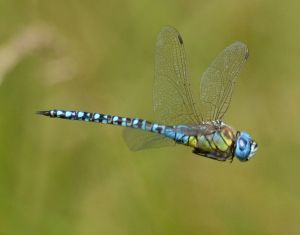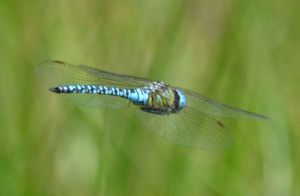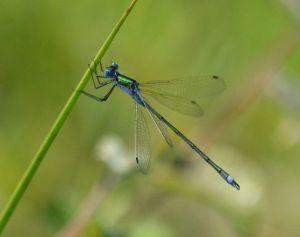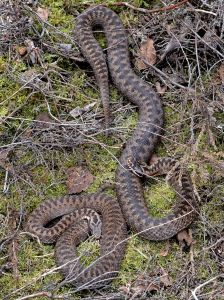The county of Essex where I grew up has some choice odonata specialities, two of which prior to yesterday I had recorded just once each. These are Blue-eyed (or Southern Migrant) Hawker dragonfly and Scarce Emerald damselfly that occur in marshlands along the northern shore of the Thames estuary. When both were reported last weekend from a particular drainage dyke on West Canvey Marsh this was an opportunity to experience them properly. I had seen just one deformed individual of the first-named before (see here), while the latter was a matter of removing all doubt.
This is the fourth season since Blue-eyed Hawker arrived in England around here. When news got out from Wat Tyler Country Park on the southern outskirts of Basildon in 2014, the odo equivalent of a mass twitch ensued. Prior to then there had been just three national records. In mainland Europe the species is present permanently only around the Mediterranean, but there can be influxes further north in hot summers. It’s range in Essex has expanded somewhat since 2014, thankfully since a country park in the school summer holiday is not an ideal environment for serious observation.
I parked at South Benfleet railway station and walked out across Benfleet Creek, arriving on site just before midday. Opposite a local authority recycling facility a public footpath gives access to a stretch of sea wall (TQ779852) to the southern side of which lies the ditch in question. It didn’t take long to encounter a first Blue-eyed Hawker (pictured below): a medium sized, bright blue hawker with even more vivid blue eyes. Even by dragonfly standards these are seriously beautiful creatures, if a little prone to grassy poses.
The weekend post on the BDS sightings page cited more than 30 males along the length of this dyke. I continued to walk westwards and began to see Emerald damselflies as well, but were they of the right variety? I had forgotten to read up on the diagnostics before leaving the station car park, but now some of it came back to me and on the back of the camera these insects looked right for Scarce Emerald. Company arrived at this point in the form of two more odo hunters, one of whom said this was the place to see what is a highly localised damselfly 20 years ago. But both were much more interested in the star hawkers.
On reviewing my pictures (below) they all showed the correct characteristics for Scarce Emerald. Abdominal segment 1 and half of 2 are blue, with two darker spots on the blue part of segment 2. In Common Emerald both segments are plain blue. The second key diagnostic is the inner anal appendages that in Scarce Emerald are broader and more inwardly curved than for common. Brooks and Lewington also cites squarer shape of the pterostigma (black wing tags) and brighter blue eyes.
It had been much easier to identify this insect positively here than at nearby RSPB Bowers Marsh a year ago (see here). Then just one or two had been mixed in with Common Emerald and were in immature colouring. There were many more at the Canvey Island site this time as the BDS sighting had stated. So all doubt concerning what was the final species on my English damselfly list has been well and truly removed.
I next continued searching along the dyke for more Blue-eyed Hawker, counting 12 males on the walk out but there seemed to be more on the way back. One of the people I spoke to had counted 21, so between 20 and 30 at this site seems a reasonable estimate. I only hope there are females around too so this most attractive dragonfly can continue to establish itself, but I didn’t see any mating pairs on this visit. What I did see at intervals were hovering males at head height, patrolling up and down the ditch.

Blue-eyed Hawker (male)

BEH has a penchant for hovering, keeping still for relatively longer than other hawkers, which makes it easier to photograph. The upper picture, above was the icing on the cake of a pleasing experience, while I also like the lower capture of the dragonfly through it’s own wings. It is always a bonus to obtain flight shots. This had been a fairly brief visit of around three hours, in between peak periods on the M25 motorway, and I would like to come here again for longer in the future. With more reports getting out on-line I suspect this site will be very well attended this summer.

























